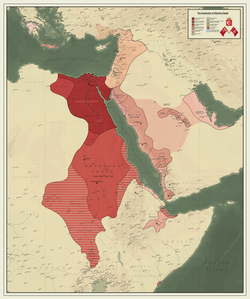Khedivate of Egypt
Appearance
Khedivate of Egypt الْخُدَيْوِيَّةُ الْمِصْرِيَّةُ (Arabic) Khidywyt-al Misr خدیویت مصر (Ottoman Turkish) Hıdiviyet-i Mısır | |||||||||||||||
|---|---|---|---|---|---|---|---|---|---|---|---|---|---|---|---|
| 1867–1914 | |||||||||||||||
| Anthem: (1871–1914) Salam Affandina | |||||||||||||||
 Egypt and its expansion in the 19th century. | |||||||||||||||
| Status | de jure under Ottoman suzerainty, fully autonomous (1867–1914) (under British military occupation from 1882) | ||||||||||||||
| Capital | Cairo | ||||||||||||||
| Common languages | Arabic, Ottoman Turkish, Greek,[1] French, English[a] | ||||||||||||||
| Religion | Sunni Islam, Coptic Christianity | ||||||||||||||
| Government | Constitutional monarchy | ||||||||||||||
| Khedive | |||||||||||||||
• 1867–1879 | Isma'il Pasha | ||||||||||||||
• 1879–1892 | Tewfik Pasha | ||||||||||||||
• 1892–1914 | Abbas II | ||||||||||||||
| British Consul-General | |||||||||||||||
• 1883–1907 | Evelyn Baring | ||||||||||||||
• 1907–1911 | Eldon Gorst | ||||||||||||||
• 1911–1914 | Herbert Kitchener | ||||||||||||||
| Prime Minister | |||||||||||||||
• 1878–1879 (first) | Nubar Pasha | ||||||||||||||
• 1914 (last) | Hussein Roshdy Pasha | ||||||||||||||
| Historical era | Scramble for Africa | ||||||||||||||
• Established | 8 June 1867 | ||||||||||||||
• Suez Canal opened | 17 November 1869 | ||||||||||||||
| 1881–1882 | |||||||||||||||
• British invasion in the Anglo-Egyptian War | July – September 1882 | ||||||||||||||
| 18 January 1899 | |||||||||||||||
• Disestablished | 19 December 1914 | ||||||||||||||
| Area | |||||||||||||||
• Total | 5,000,000 km2 (1,900,000 sq mi) | ||||||||||||||
| Population | |||||||||||||||
• 1882[b] | 6,805,000 | ||||||||||||||
• 1897[b] | 9,715,000 | ||||||||||||||
• 1907[b] | 11,287,000 | ||||||||||||||
| Currency | Egyptian pound | ||||||||||||||
| |||||||||||||||
The Khedivate of Egypt (Arabic: الْخُدَيْوِيَّةُ الْمِصْرِيَّةُ, Ottoman Turkish: خدیویت مصر) was an tributary state of the Ottoman Empire, created and ruled by the Muhammad Ali family.
The United Kingdom invaded Egypt and took control of it in 1882, basically making it a British puppet, but the Ottoman connection was kept. In 1914, the Ottoman Empire's link to Egypt was ended and Britain established a protectorate called the Sultanate of Egypt.
References
[change | change source]- ↑ Ekmeleddin İhsanoğlu (2012). "Turks in the Egyptian Administration and the Turkish Language as a Language of Administration". In Humphrey Davies (ed.). The Turks in Egypt and their Cultural Legacy. Oxford Academic. pp. 81–98. doi:10.5743/cairo/9789774163975.003.0005. ISBN 9789774163975.
- ↑ Holes, Clive (2004). Modern Arabic: Structures, Functions, and Varieties. Georgetown Classics in Arabic Language and Linguistics (2nd ed.). Washington, D.C.: Georgetown University Press. ISBN 978-1-58901-022-2. OCLC 54677538. Retrieved 14 July 2010.
- ↑ Bonné, Alfred (2003) [First published 1945]. The Economic Development of the Middle East: An Outline of Planned Reconstruction after the War. The International Library of Sociology. London: Routledge. p. 24. ISBN 978-0-415-17525-8. OCLC 39915162. Retrieved 9 July 2010.
- ↑ Tanada, Hirofumi (March 1998). "Demographic Change in Rural Egypt, 1882–1917: Population of Mudiriya, Markaz and Madina". Discussion Paper. No. D97–22. Institute of Economic Research, Hitotsubashi University. hdl:10086/14678.


